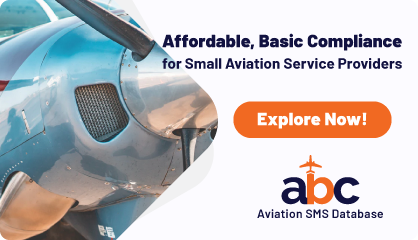Managing FAA, ICAO & EASA Requirements
Aviation Safety Management Systems (SMS) must align with the core frameworks of the FAA (14 CFR Part 5), ICAO (Annex 19), and EASA (integrated into domain-specific regulations like Part-OPS, Part-145, and Part-21). These bodies emphasize the four pillars of SMS:
- Safety Policy,
- Safety Risk Management,
- Safety Assurance, and
- Safety Promotion
These areas must be covered in every SMS, and at the same time, promoting scalability for different organization sizes, hazard information sharing, and integration with broader management systems.
Effective SMS software or tools should automate compliance, foster a just safety culture, and enable proactive risk mitigation. These tools have the ability to facilitate SMS regulatory compliance and also save organizations time and money complying with these requirements.
Most Important Aviation SMS Features
Below lists an SMS' most important features, prioritized based on regulatory alignment and practical implementation benefits (e.g., reducing audit preparation time by up to 50% and incident response by 15-30%). These features support gap analyses, implementation plans, and ongoing monitoring required by all three authorities.
| Feature | Description | Alignment to FAA/ICAO/EASA |
|---|---|---|
| Hazard Reporting Portal | User-friendly, anonymous mobile/web interface for employees to submit incidents, near-misses, and hazards in real-time, with automated notifications and workflow routing to safety managers. | Core to ICAO's Safety Risk Management pillar; supports FAA's hazard notification and protection rules (§5.21); enables EASA's just culture promotion under integrated management systems. |
| Risk Assessment & Mitigation Tools | Built-in matrices (e.g., 5x5 severity/likelihood grids) for identifying, prioritizing, and tracking risks, including Flight Risk Assessment Tools (FRAT) with customizable FAA templates. | Directly fulfills ICAO Annex 19 risk mitigation elements; aligns with FAA's SRM processes (AC 120-92D); supports EASA's hazard identification in Part-21/Part-145 for design/maintenance risks. |
| Audit & Compliance Management | Automated checklists, gap analysis templates, and dashboards for internal/external audits, with e-signatures and evidence upload to track corrective actions. | Facilitates FAA implementation plans (§5.19) and declarations of compliance; matches ICAO's Safety Assurance for performance monitoring; ensures EASA's domain-specific audits (e.g., Part-OPS). |
| Safety Performance Monitoring Dashboard | Real-time analytics, KPIs (e.g., bird strikes, tool control, etc.), and trend visualizations for safety metrics, with alerts for thresholds. | ICAO's Safety Assurance pillar for continuous improvement; FAA's safety assurance requirements (§5.81); EASA's emphasis on safety performance indicators in integrated MS. |
| Training & Competence Tracking | Integrated LMS for SMS-specific training modules, role-based assignments, and record retention, including just culture and emergency response simulations. | Supports FAA's training elements (§5.91) and recordkeeping; ICAO's Safety Promotion for competence; EASA's personnel training under Part-FCL/Part-145. |
| Document & Policy Management | Centralized repository for safety policies, manuals, and updates, with version control and automated distribution to ensure accountability (e.g., accountable executive sign-off). | ICAO's Safety Policy component; FAA's policy requirements (§5.11); EASA's integrated MS for policy integration across approvals. |
| Confidential Information Protection | Encryption, access controls, and non-punitive reporting to protect data, with options for de-identification and FAA/EASA-approved sharing protocols. | FAA's hazard protection (§5.17); ICAO's data exchange guidelines (Doc 9859); EASA's confidentiality under Regulation 376/2014. |
| Scalable Integration with Other Systems | API connectivity to flight ops, maintenance (e.g., Part-145), and ERP software, with modular setup for small/large operators. | FAA's scalability (§5.5); ICAO's proportionate implementation; EASA's single MS for multi-approval holders (e.g., Part-21 + Part-145). |
| Safety Culture Surveys & Promotion Tools | Automated feedback surveys, newsletters, and gamification (e.g., badges for reporting) to build engagement and measure culture maturity. | All three emphasize promotion: ICAO's Safety Promotion pillar; FAA's voluntary programs (SMSVP); EASA's focus on fostering reporting culture. |
| Emergency Response & Drill Planner | Templates for ERP plans, simulation scheduling, and post-event reviews, integrated with risk registers for proactive drills. | FAA's emergency planning (§5.61); ICAO's risk management extensions; EASA's crisis management in air ops regulations. |
These features, when implemented via compliant software (e.g., SMS Pro or ABC), streamline SMS across pillars while meeting deadlines like FAA's May 2027 rollout or EASA's recent 2024 Part-145 mandates.
Starting or Reviewing SMS Implementation
To review or initiate an aviation SMS, start with a gap analysis against ICAO Doc 9859 to prioritize required elements based on your operations and timeline.
After completing your gap analysis, I recommend acquiring an FAA approved electronic recordkeeping system before getting too far into the weeds with your SMS implementation. This step will save considerable rework and time.
Conclusion
Only 3% of the population are intuitive system thinkers. An SMS, by its name is an integrated "system" structured per ICAO's four pillars and 12 elements. Most people wrongly believe that SMS is a simple concept and are not "forced" to learn and understand how each pillar affects its three siblings. The purpose of this article was to demonstrate the most important features of an SMS for new safety managers or for veterans to review and analyze their existing systems.
The above list of major features in an aviation SMS should be familiar to most users. Furthermore, you may already be using some of these tools in a fragmented SMS data collection and management framework. For those needing an integrated system with all these features collected in a single framework, consider acquiring a professional SMS database designed specifically to address ICAO SMS requirements.
Aviation SMS databases save time and organizational resources.





